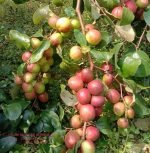

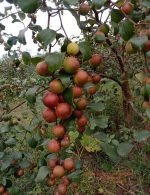
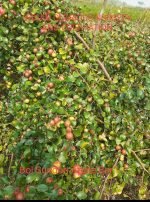


BALL SUNDORI RED APPLE BER
₹210.00 Original price was: ₹210.00.₹169.00Current price is: ₹169.00.
The apple tree (Malus pumila, or Malus Domestica) is, in particular, be known as the KING of all fruits. Because this fruit has so many virtues. An apple is beautiful, tasty, and has a fine fragrance. It is cultivated worldwide as a fruit tree and originated in Central Asia. Apples can grow anywhere, excluding extremely hot or extremely cold climates. On the outside, it is a colourful fruit. It comes in various colours from green to red to gold. In taste, an apple is tasty and juicy and has various tastes from sour to sweet. One can eat an apple raw, cooked, or baked, and it can be used in various dishes. Apples are very good for one’s health. An English saying is AN APPLE A DAY KEEPS THE DOCTOR AWAY.
[WE ARE SPECIALIST OF INDIAN & EXOTIC MANGO VARIETIES]
India’s most trusted Nursery plants supplier (Wholesale & Retailer). Govt. registered Nursery. Supplier of all kinds of quality fruit plant, road side plants, Hilly area plants, flower plants, (Specialist of Indian & exotic Mango Varieties)
| POT | No (Normal paper bag)/grow bag. |
| MAINTENANCE | Best fruit plant, easy maintenance & fast-growing Plant |
| WATER SCHEDULE | Need Every-Day watering during its first three years of growth. After this, you will only need to water it during extended periods of drought. It is not necessary to water during fall or winter. |
| PLANT’S DIMENSION | Plant height with pot is 3fit+/Full ready plants. |
| SUN EXPOSURE | Thrives in direct sun light, but can tolerate low indirect light. |
| DELIVERY TIME: | Now if you do Order. We will dispatch as soon as possible |
| SYSTEM OF PACKING | .Live packing/Live loading via WhatsApp video call. |
| COURIUR &
DELIVERY MODE | DTDC / BLUE DART / ECOM EXPRESS/ DELIVERY/ TRAIN DELIVERY/FULL TRACK LOADING. |
| DISPATCH TIME | Delivery Time With in 2-6 Days |
| Return policy | If your Plant Delivery Time Damaged , so we will Send your plant Again , |
* ALL PLATS ARE GRAFETD AND 100% ORGINAL VERITY.
* If you have any damaged plants please Email us at info.ignc@gmail.com/Whatapp/Call-8967664936 and specify which plants were damaged. You may request an exchange within 3-5 days of delivery.
The apple tree (Malus pumila, or Malus Domestica) is, in particular, be known as the KING of all fruits. Because this fruit has so many virtues. An apple is beautiful, tasty, and has a fine fragrance. It is cultivated worldwide as a fruit tree and originated in Central Asia. Apples can grow anywhere, excluding extremely hot or extremely cold climates. On the outside, it is a colourful fruit. It comes in various colours from green to red to gold. In taste, an apple is tasty and juicy and has various tastes from sour to sweet. One can eat an apple raw, cooked, or baked, and it can be used in various dishes.
HEALTH BENEFITS OF APPLE
Apples are very good for one’s health. An English saying is AN APPLE A DAY KEEPS THE DOCTOR AWAY. An apple is good for one’s digestion, and also has important vitamins and minerals. Apples also help to clean one’s teeth after a meal. Good for Weight Loss and good for your heart. Substances in apples may help prevent cancer. Apples contain compounds that can help fight asthma. The antioxidants in apples may help protect your brain in old age.
MAINTENANCE OF THE PLANTATION
Once a plantation has been established, the work should not be considered finished. It will be necessary, for example, to protect the plantation against weather, fire, insects and fungi, and animals. A variety of cultural treatments also may be required to meet the purpose of the plantation.
FERTILIZING
Generally, no manures or fertilizers are applied to the rain-fed crops. However, a fully grown tree recommends the following dose for early and bumper harvest with a good keeping quality. Bio meal 10 kg, 5:10:5 1 Kg. Ormichem micronutrient mixture 0.250 kg at the time of flowering and another dose of 10:26:26 or 19: 19: 19 mixture after fruit set. Foliar spray with 8:12:24:4 10 gm/lt, twice during fruit development. Occasionally, zinc or iron or both deficiencies are noticed and can be taken care of by spraying chealed zinc or Ferrous.
WATERING AND WEED CONTROL
Young apple trees should be watered regularly until fully established. In dry western climates, water mature trees deeply at least every one or two weeks. Desert gardeners may have to water more frequently. Mulch the soil around the trees to conserve moisture. Weeding is also very important. Remove all weeds 1.5 meters around the plant.
PRUNING AND TRAINING
As the trees mature they will only need light pruning in late August – September. In mid-summer tip prune and remove the two leaves at the end of the branch. This will promote fruiting wood.
PEST & DISEASE FOR APPLE TREES
Every fruit tree has the future potential for disease and insect damage. Factors such as location and weather will play a part in which issues your tree encounters. If available, disease-resistant trees are the best option for easy care; and for all trees, proper maintenance (such as watering, fertilizing, pruning, spraying, weeding, and fall cleanup) can help keep most insects and diseases at bay.
HARVESTING YOUR APPLES
The apples should be picked when mature, yet hard, with mature skin colour but a hard flesh. Gently remove the apples from the tree, keeping the stem intact. Sort through the apple harvest and remove any apples that have insect erosion.
PLANTING INSTRUCTIONS
1. Prioritize your tree planting with the sun’s direction to maximize shade by planting on the southwestern and western sides of your home
2. Apple trees can grow in a wide range of soils from medium-textured clays to gravelly sands. However, poor soils will produce poor results and the best crops are found on fertile sandy soils and loams.
3. For Commercial Plantation, the average number of plants in an area of one ha. can range between 200 to 1250. Four different categories of planting density are followed viz. low (less than 250 plants/ha.) moderate (250-500 plants/ha.), high (500-1250 plants/ha.) and ultra high density (more than 1250 plants /ha.). The combination of rootstock and scion variety determines the plant spacing and planting density/unit area.
4. In a home garden, generally we are planting one or two apple trees and other fruit plants species. So it is better to keep a minimum of 3 meters distance from other plants to plant an apple tree.
5. 100% sunlight is best but can grow up to 50 % shade
6. During dry weather, initially water the plant once in two days and after one month of planting water every 7 to 10 days during the first year.
7. Do not use chemical fertilizer or any other chemicals on your newly planted trees. Such products will kill your young trees. If needed you can add chemical fertilizers in small quantities (generally below 100gm) after two to three months of planting with sufficient irrigation.
8. Do not overwater or allow rainwater so much that you see standing water in the pit area of the plant. It will damage the plant’s roots and results in the die of your plant.
Only logged in customers who have purchased this product may leave a review.


For domestic buyers, orders are shipped through registered domestic courier companies and /or speed post only.
We do not ship Indian Glorious Nursery products out of India.
Orders are shipped within 7 working days or as per the delivery date agreed at the time of order confirmation and delivering of the shipment subject to Courier Company/post office norms.
Indian Glorious Nursery is not liable for any delay in delivery by the courier company / postal authorities and only guarantees to hand over the consignment to the courier company or postal authorities within 7 working days from the date of the order and payment or as per the delivery date agreed at the time of order confirmation.
Delivery of all orders will be to the registered address of the buyer as per the credit/debit card only at all times(Unless specified at the time of Order). Indian Glorious Nursery is in no way responsible for any damage to the order while in transit to the buyer.


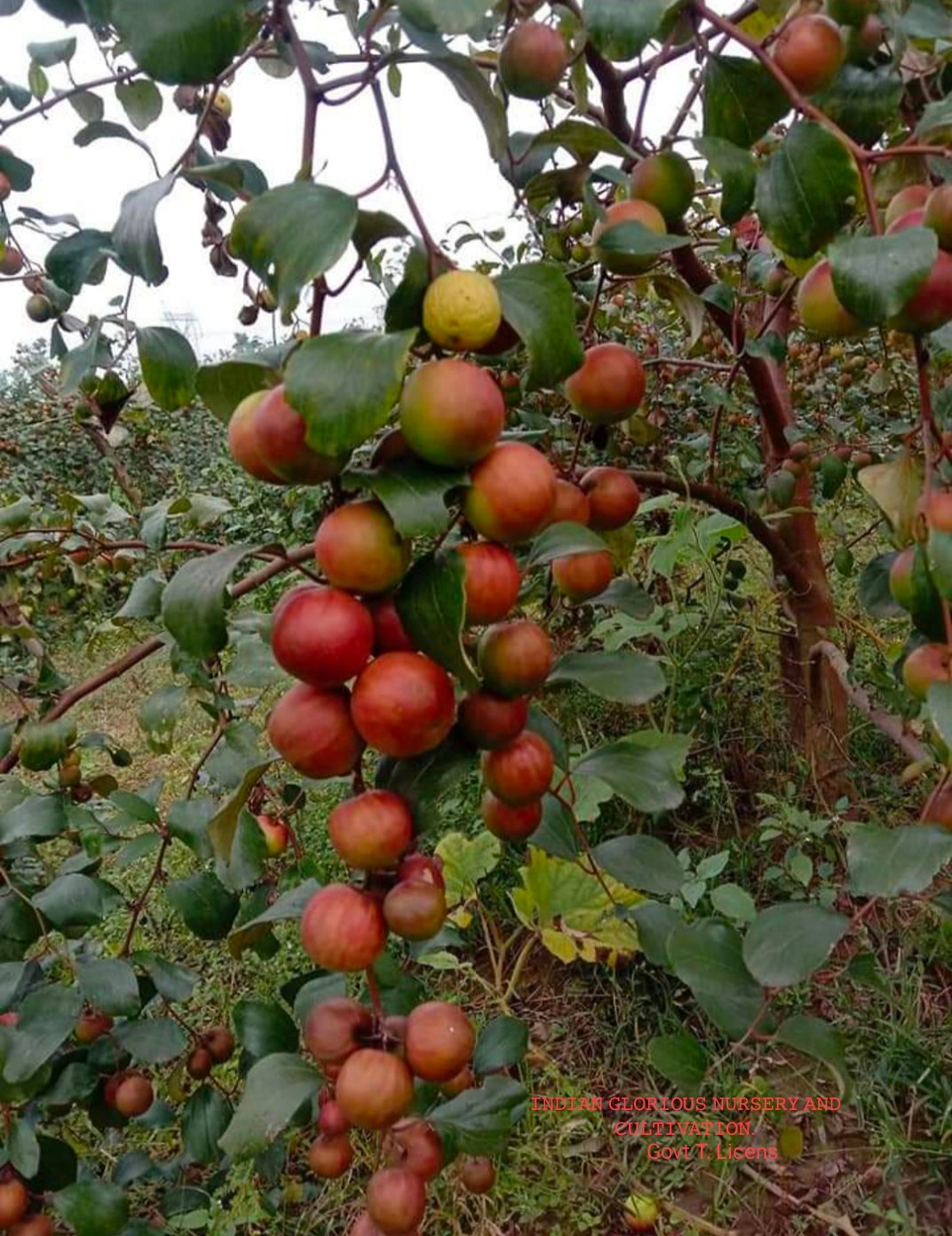


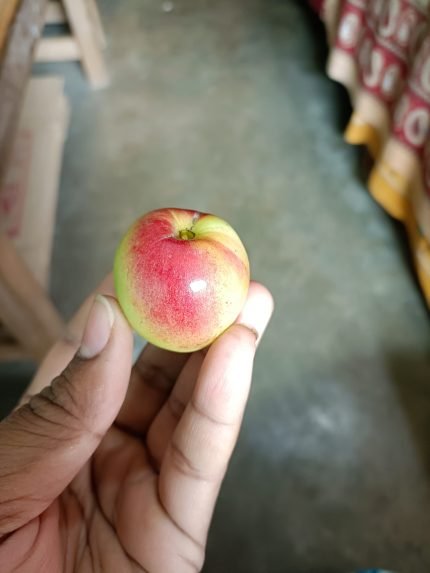

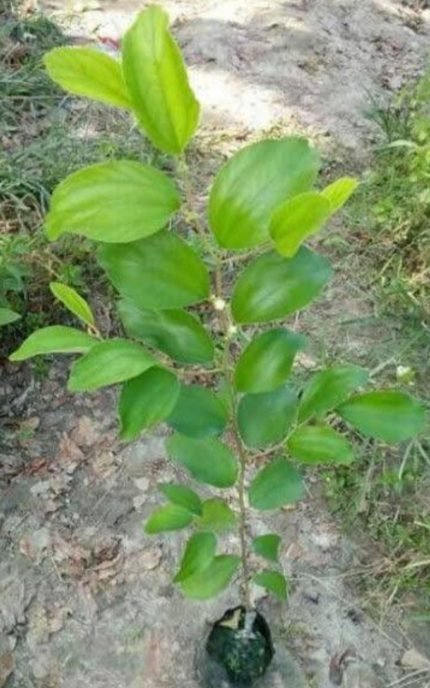











Reviews
There are no reviews yet.